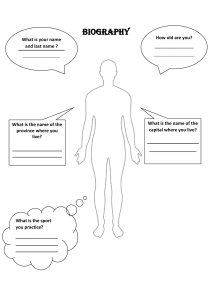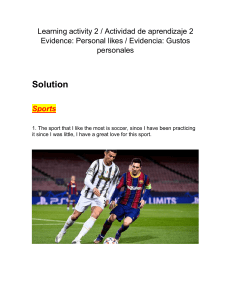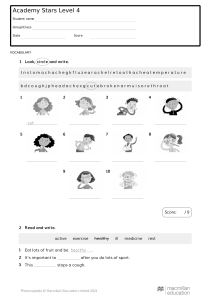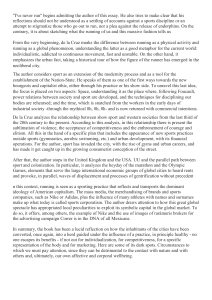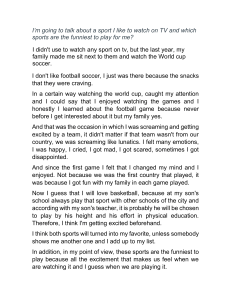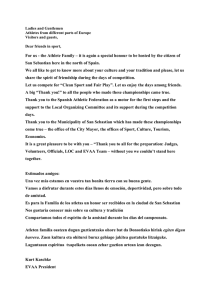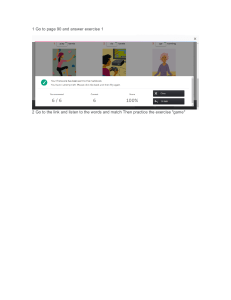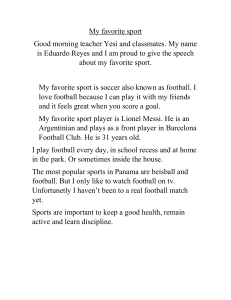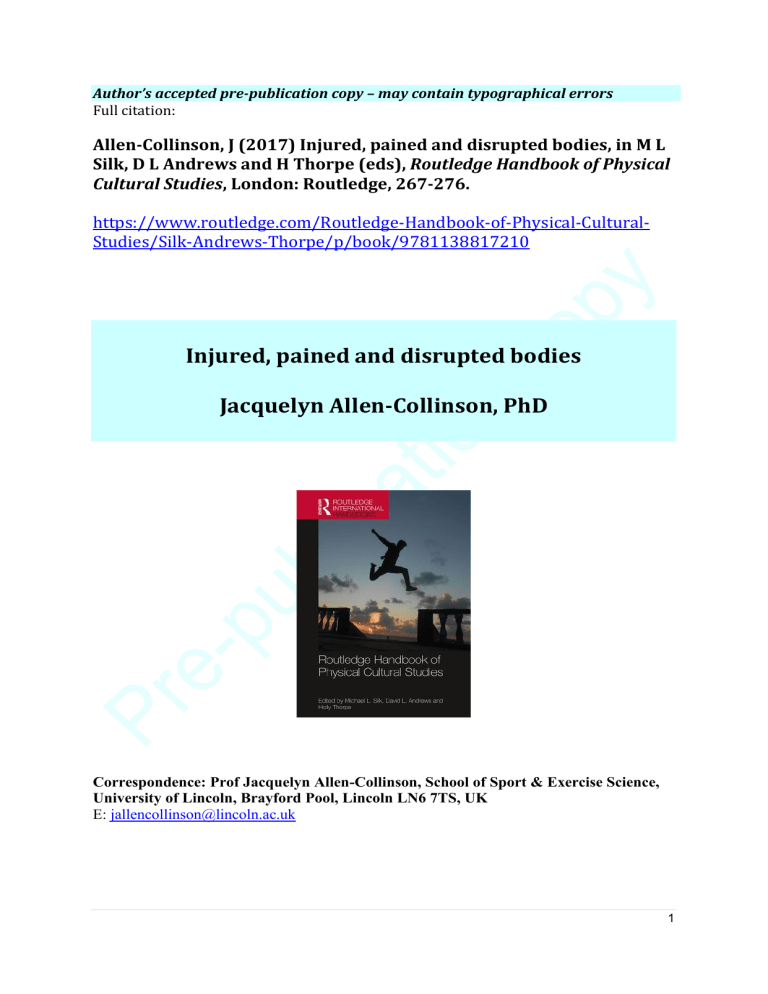
Author’s accepted pre-publication copy – may contain typographical errors
Full citation:
Allen-Collinson, J (2017) Injured, pained and disrupted bodies, in M L
Silk, D L Andrews and H Thorpe (eds), Routledge Handbook of Physical
Cultural Studies, London: Routledge, 267-276.
https://www.routledge.com/Routledge-Handbook-of-Physical-CulturalStudies/Silk-Andrews-Thorpe/p/book/9781138817210
Injured, pained and disrupted bodies
Jacquelyn Allen-Collinson, PhD
Correspondence: Prof Jacquelyn Allen-Collinson, School of Sport & Exercise Science,
University of Lincoln, Brayford Pool, Lincoln LN6 7TS, UK
E: [email protected]
1
Introduction
All too commonly, pain and injury constitute integral components of participation in many sports
and physical cultures, even those not usually constructed as dangerous or ‘high-risk’. This was
highlighted in the news in 2014 by the untimely death of the young Australian cricketer Phillip
Hughes, who was struck on the neck by a ball from a pace bowler while batting in a domestic
game, and died two days afterward, never regaining consciousness. Gone. Killed playing the
game he loved. While such a catastrophic injury is thankfully rare in cricket, nevertheless, pain,
injury and bodily disruption are widespread and often normalized within sport and physical
cultural domains, where a ‘culture of risk’ can be argued to prevail. Adopting a transdisciplinary
approach commensurate with PCS, this chapter explores some of the extant sociological,
anthropological, and social-psychological research on active embodiment in relation to injured,
pained and disrupted bodies. From the myriad different approaches available in researching this
area, here I focus upon the impact of identity disruption and the role of ‘identity work’ in dealing
with the injured body in the physical-cultural context of distance running, drawing on data from
two automethodological projects. The concept of ‘identity work’ has been utilized within various
disciplines, and here is theorized from a symbolic interactionist perspective specifically. This
sociological theoretical framework investigates the relational, processual and subjective
elements of identity and embodiment, and thus coheres with the PCS enterprise. It offers
powerful analytic insights in examining the injured and pained body as experienced within
physical cultures, including within the normative structures of those cultures.
In order to highlight the potential of this particular theoretical framework, I provide illustrative
data derived from multiple sources: a collaborative autoethnographic project on long-term injury
in distance runners (Allen-Collinson and Hockey, 2008), and an autophenomenographic study
of female distance running. Here, I explore the role of ‘identity work’ in sustaining identity
during the liminality of ‘injury time’, when the self–body relation is often experienced as
severely disrupted. From a sport-psychological perspective, Petrie has highlighted the traumatic
nature of injury experiences in physical cultures, and the deleterious consequences for identity:
Serious injury is one of the most emotionally and psychologically traumatic things
that can happen to an athlete … Because athletes are so dependent upon their
physical skills and because their identities are so wrapped up in their sport, injury
can be tremendously threatening to them.
(Petrie, 1993: 18–19)
In order to provide insight into the socio-cultural framing of pain and injury experiences in
physical cultures, commensurate with a PCS perspective, I first consider some of the extant
sociological (and anthropological) literature on sports pain and injury. Over the past 20 years, a
corpus of such literature has developed, which examines pain and injury vis-à-vis key sociocultural variables, and situates embodied experience within the specificities of particular physical
cultures. In relation to gender, for example, Young and White (1995) examine the experiences
of young, elite female athletes, and Pike (2005) explores the role of non-orthodox sports
medicine in female rowers’ efforts to maintain their identities during the disruptive processes of
2
injury and illness. With regard to ageing processes, Wainwright and Turner (2006) consider
embodiment issues in relation to older ex-dancers, highlighting that both injury and ageing
generate epiphanies for these dancers, forcing them to reflect on their embodied selves and
career. Tulle (2007, 2008) similarly addresses ageing and embodiment in her accounts of the
experiences of veteran runners. At the other end of the age spectrum, Pike (2010) charts the
worlds of elite child athletes and their exposure to injury risk.
The (sub)cultural context and ethos of specific physical cultures where endurance and
training/performing through pain and injury are valorized and normalized has been analysed in
physical cultures as diverse as rugby (Howe, 2004), distance running (Allen-Collinson and
Hockey, 2008), boxing (Wacquant, 1995; Woodward, 2009; Paradis, 2012; Allen-Collinson and
Owton, 2015), martial arts (Channon and Jennings, 2013) and mixed martial arts (Spencer,
2012). As Wiese-Bjornstal et al. (1998: 63) noted of the sport–pain–injury nexus, ‘athletes learn
to define sacrifice, risk, pain, and injury as the price one must pay to be a true athlete in
competitive sports’, and this applies not only at the elite level, but also to other highly committed
participants. Sociological and anthropological research has focused on the enduring of pain as a
subcultural practice in extreme and/or endurance sports (e.g. Reischer, 2001; Atkinson, 2008).
Such practice often requires stoicism of body and mind; ‘stoicism’ being defined as the
exercising of endurance in the face of adversity (Moore et al., 2012: 162). The normalization of
sacrifice, risk, pain and injury is not, however, necessarily always positive or productive and the
substantial corporeal (and psychological) dangers generated by acceptance of such a ‘culture of
risk’ have also been highlighted (for example, Safai, 2003).
While running is not deemed a high-risk sport, within the distance runner’s life-world, risk,
sacrifice, endurance and stoicism in the face of pain and injury are normative (Hockey and AllenCollinson, 2015). Indeed, distance running requires of its adherents the psychological and
physical ability to tolerate on a regular and frequent basis the pervasive fatigue, discomfort and
pain generated by everyday training routines that require ‘putting in the miles’, whatever the
weather and state of bodily being. As distance running and racing require huge and sustained
volumes of training at a certain intensity of pace, these practices develop physical and
psychological endurance. Within the distance running subculture, the desire and ability to endure,
to keep on running in the face of fatigue and pain – and also certain kinds of injury – is highly
valorized. That being said, however endemic and normalized fatigue, exhaustion, discomfort,
pain and routine injury are within the distance runner’s life-world, serious injury is nevertheless
often encountered as a threat to running identity, producing a ‘disruption of self’ (Turner and
Wainwright, 2003: 272) that can require sustained remedial identity work.
To date, the literature on the identity work undertaken by participants in physical cultures who
suffer disruption to their identity is relatively sparse. This lacuna is particularly noticeable in
relation to those participating at non-élite or grassroots levels, but who are nevertheless serious
and highly committed physical culture participants. For these individuals, enforced retirement or
withdrawal from their chosen physical cultural activity can engender deep disruption to the
body–self and to the physical–cultural life-world (Lebenswelt). Although authors have certainly
challenged the inevitability of biographical disruption as a result of illness (e.g. Faircloth et al.,
3
2004), the assault on identity generated by illness, pain and injury has been well documented in
sociology generally (e.g. Becker, 1997) and in relation to sport specifically (e.g. Sparkes and
Smith, 2003; Owton and Allen-Collinson, 2014). Given the centrality of the body in most sports
and physical cultures, body-disruptive events and processes such as injury and illness often result
in ‘disrupted body projects’ (Sparkes, 2002), and physical–cultural biographical disruption.
Material, corporeal disruption can also have deleterious consequences for a person’s felt and
lived identity, for as Budgeon (2003) notes, subjectivity and the material body are aspects of the
self which are irreducibly linked so that bodies are never just objects but part of a process of selfidentity (re)negotiation and re-negotiating. Such disruption can require of sports participants
sustained engagement with ‘identity work’ in order to provide some sense of identity continuity.
Here, I draw specifically upon the conceptualization of identity derived from the microsociological theoretical perspective of symbolic interactionism, which theorizes identity as an
interactional, ongoing achievement, and has some conceptual overlap with social-psychological
theorizations. Below, I discuss the concept of identity work and its constituent components
before portraying illustrative data from the two research projects on sports injury in distance
running, in order to ground abstract theoretical insights in a specific physical-cultural context.
Symbolic interactionist perspectives on identity and identity work in sport
Sociological concepts of identity have been subject to intense scrutiny and critique during the
last few decades (Callero, 2003), particularly from poststructuralist theorists, who problematize
notions of any fixed, stable identity, and highlight the fluidity and mutability of subjectivities.
Poststructuralist accounts highlight how subjectivity is formulated through discourses, given
substance and pattern through storyline and deployed in social interaction (Davies and Banks,
1992). This perspective holds strong analogies with the older tradition of symbolic
interactionism (SI), which also challenged notions of the existence of some ‘true’ inner self, as
fixed and temporarily consistent. SI theorists argued for the construction, emergence and
presentation of self and identity within interactional milieu (Blumer, 1969; Goffman, 1969).
These theorizations of identity range along a continuum between structural and more
‘processual’ perspectives, with the latter focusing analytic attention on social agency and the
processes of identity construction in interaction; elucidating the ways in which identities are
actively negotiated in social contexts, but within overarching social-structural frames. Of
further analytic relevance is the distinction made by some theorists (e.g. Snow and Anderson,
1995) between: social identities and personal identities. The former are conceptualized as those
we attribute or impute to social others, whereas personal identities refer to meanings we
ourselves attribute to self. Social and personal identities do not always necessarily coincide,
and individuals may have to engage in sustained identity work to present a social identity
congruent with their own felt personal identity, especially when challenged by those with
greater social power, as Goffman (1973) acutely observed in relation to those with stigmatized
social identities. This takes us to the symbolic interactionist concept of identity work,
succinctly defined by Snow and Anderson as:
the range of activities individuals engage in to create, present and sustain personal
identities that are congruent with and supportive of the self-concept. So defined,
identity work may involve a number of complementary activities: a) arrangement
4
of physical settings or props; b) cosmetic face-work or the arrangement of personal
appearance; c) selective association with other individuals and groups; d) verbal
constructions and assertion of personal identities. (Snow and Anderson, 1995: 241)
A similar formulation has been adopted by Perinbanayagam (2000), who employs analogous
categories of ‘materialistic’, ‘associative’ and ‘vocabularic’ identifications, which map on to
Snow and Anderson’s categories, but amalgamate physical settings, props and the arrangement
of physical appearance under the category of ‘materialistic’ identification. Concepts of
materialistic and vocabularic identification are utilized in the analysis below, which theorizes
from data generated by two research projects on distance running, one collaborative
autoethnographic project and one autophenomenographic; the former focusing on an extended
injury (and rehabilitation) period of two years, and the latter incorporating several shorter injury
periods.
The research projects
Although autoethnography is a research approach increasingly familiar in social-science
communities (Allen-Collinson, 2013; Holman Jones et al., 2013), autophenomenography may
be less familiar to readers. This approach is analogous to autoethnography but where the
researcher analyses her/his own experiences of a phenomenon rather than specifically of a
cultural/subcultural domain (Allen-Collinson, 2011), as would constitute the focus in
autoethnography, although there is inevitable overlap. Running 1 (R1) was a collaborative
autoethnography undertaken in conjunction with a fellow runner–researcher (see AllenCollinson and Hockey, 2008), as two highly experienced ‘veteran’ distance runners. Systematic
data collection was via highly detailed individual training/research logs, and a shared ‘analytic
log’, over a two-year period of long-term injury and rehabilitation. In the analytic log, we shared
emergent analytical themes and concepts, and wrote up longer, more evocative narratives based
on field-notes. Data recording was via notebooks and micro tape recorders, the latter
accompanying us on training sessions, and sometimes to physiotherapy appointments. During
the research process, we engaged in epochē or phenomenologically inspired bracketing, by,
among other things, subjecting to analytic questioning the influence of our own personal
embodiment on the meanings, beliefs and knowledge we utilized and generated. In Running 2
(R2), an autophenomenographic project on women’s running, I similarly maintained detailed
training/research logs for three years, initially commencing in 2008 and then recommencing in
October 2012 having moved to a new city. These logs also incorporate various periods of injury,
primarily relating to knees and also ongoing problems with an increasingly arthritic foot.
Autoethnographers and autophenomenographers analytically write themselves into fieldwork
accounts, as an integral part of the research process, and some may choose to adopt a highly
personal, evocative, emotional and evocative style (e.g. Douglas and Carless, 2006). Writing in
such a personal, emotional style can involve risk in challenging notions – still prevalent within
more traditional academic quarters – that researcher–authors should be ‘neutral’, more
‘objective’, distanced, and ‘silent’ (Sparkes, 2002). Such a transgressive stance can make
autoethnography/autophenomenography, and more novel forms of qualitative research in
general, vulnerable to accusations of being ‘irrational, particularistic, private, and subjective,
5
rather than reasonable, universal, public, and objective’ (Greenhalgh, 2001: 55). While this
chapter does present autoethnographic and autophenomenographic findings, these are framed in
a more traditional, ethnographic–realist manner, given my primary purpose here is to engage in
theoretical analysis of identity work, rather than generate a more evocative account.
Commensurate with the automethodological approach, it is important to offer some accountable
knowledge to situate myself – and my co-researcher1 in R1 – within the research. Now into my
mid-fifties, I have been running since my mid-twenties (being a ‘late starter’), and a veteran
runner (in the UK classificatory system) for 20 years. Together with my co-runner and coresearcher on the collaborative project, we regularly trained together, often six or seven times a
week. The chronic knee injuries that we both suffered some years ago constituted the focus of
the collaborative autoethnographic project, initiated in order to document engagement with the
emotional oscillations of the injury and rehabilitation process. These injuries, painful, frustrating
and running-career-threatening, were incurred in the same week of winter training when, on
separate evenings, forced by work demands to train in the dark, I stumbled into a fallen branch,
twisting my right knee viciously, and my partner slid on a muddy stretch, wrenching his left
knee. Some few days subsequently, having adhered to the usual conventions of RICE – that is,
rest (relative), ice, compression, elevation – to no avail, it became clear that the injuries were
substantially more severe than the usual ‘niggles’ plaguing habitual runners. We decided to
document systematically the injury–rehabilitation process via the methods described above. At
this point, we engaged in what Frank (1995; see also Carless and Douglas, 2010) terms the
‘restitution narrative’, seeking a return to our former running ‘gloried self’ (see also AllenCollinson, 2003). The return to full running fitness was not, however, a straightforward
progression, but rather a fragmented and emotionally charged timeline of progression,
regression, frustration. Only after two years of such oscillation, could we say with some degree
of confidence that we had ‘returned to running’.
Employing the conceptual framework of identity work, the data on the lived experience of
running injury, pain and disruption, drawn from the above projects, are portrayed below.
Commensurate with the PCS perspective, with its focus on embodiment as lived within social
structure and (sub)culture, I situate these findings within the physical-cultural domain of
running, and analyse them vis-à-vis the categories formulated by Perinbanayagam (2000) within
identity work: ‘materialistic’, and ‘vocabularic’ identifications. First, materialistic identification
is considered in relation to handling the corporeal and identity disruption engendered by running
injuries.
Materialistic identification: running routes and the ‘look’
The use of physical settings and presentation of a certain running-body appearance emerged as
salient in the research findings. In relation to physical settings, in both R1 and R2, during periods
of injury, the routes that had been utilized when in full running fitness were retained as walking
routes during rehabilitation. This provided some continuity of geographical and temporal space
during the disruption to normal athletic training, and to athletic identity. Not only was the same
ground trodden (albeit at a much lower pace), but we also sought to retain the same time slot for
exercise. This modified use of the same spatio-temporal training ‘hour’ represented a
commitment to sustain some form of training and, importantly, to an eventual return to full
6
running fitness. It did, however, engender considerable ambivalence, as highlighted in this
extract from my field note in R1:
Strange feeling tonight as we set off across Pittville Circus towards the park.
Normally, it takes only a few minutes to arrive at the little café hut as we settle
into our stride, but today of course we are only walking … everything passes by
much more slowly. We exchange mutual, somewhat forlorn looks, no need for
words. As far as I recall, it’s the first time we’ve both been injured and out of
running at the same time, and, for what may be a little while …
Under the rubric of this particular identification, in addition to the use of the same physical
settings, the issue of personal appearance emerged strongly from our data. The commitment to
undertake brisk walking as a (poor) substitute for usual running training, along with our stoic
resistance to overdoing the ‘comfort eating’, resulted in a degree of retention of the distinctive
runner’s ‘look’, characterized by a low BMI, lean body and (‘gaunt’ as one friend described)
features. Commensurate with Grosz’s (1994) observation regarding the body in general, the
runner’s body constitutes not only a lived body, but also an inscriptive surface upon which
running miles and demanding training practices are etched. While sharing somatic similarities
with others (anorexics, heavy smokers and drug users, inter alia, as some have told me) my
running-woman body was (and is, but less so nowadays) central to identity. So, despite enduring
the identity disruption provoked by injury, the continuity of a certain materialistic identification,
in the corporeal form of a running body, helped sustain both myself and my running partner
through the pain and frustration of the injury process. As a symbolic commitment to running
identity, a further element of material identification involved the practice of wearing running
gear during our daily brisk walks around the local park:
We’ve made a joint decision today: rather than undertaking the rehab in our usual
street clothes, we are going to walk around the park in our training gear. At least
we’ll look like runners – to ourselves as much as to anyone else. Feel a bit
ambivalent, however, as it’s somewhat poignant pulling on the training gear when
it’s all too apparent we are not running! (Field note, R1)
Running kit thus constituted a visual prop signalling continuity with former running identity and
our commitment to a future ‘full’ running identity. Our felt identity was that of runners subjected
to enforced injury time and the training gear was utilized as a form of ‘transitional object’ (Silver,
1996) to carry us through the period of running disruption. By wearing running gear, such as
trainers, tracksters and wet-weather Gore-Tex running tops, we engaged in materialistic
identification as runners, to ourselves and also to others within the local running subculture.
Materialistic identification thus intertwined closely with a second form of identity work:
associative identification. We dressed for ourselves primarily, but also toward an ‘audience’
whose validating response was sought (Stone, 1977). So, for example, other runners encountered
out on our running routes would identify us in our specific gear and either stop briefly or call out
to inquire as to why we were not actually running, nodding in empathy and uttering encouraging
remarks when informed of the bane of injury. These forms of utterance can also be theorized as
7
a form of ‘identity talk’ or vocabularic identification (Perinbanayagam, 2000).
Vocabularic identification – runners’ talk
Drawing on Snow and Anderson’s (1995) category of verbal constructions and assertion of
personal identities, Perinbanayagam’s (2000) concept of vocabularic identification proved
significant. In R1, for example, the data were replete with notes of conversations between my
running partner and myself where we made reference to our running identities either directly or
indirectly. As noted above, endurance is a key element and requirement of distance running, and
exhortations and encouragement to endure the injury process, ‘stay strong’ and ‘dig in’ feature
throughout our logs. ‘Digging in’ is UK running subcultural terminology often employed to
describe persevering under difficult and challenging circumstances. So, when the injuries were
particularly painful, frustrating or recalcitrant, we encouraged each other to persevere, to be
determined and to ‘dig in’ when the going got tough, just as we would when encountering a ‘bad
patch’ on a long run: ‘C’mon, Rosa!’ my running partner would growl, making reference to the
Portuguese Olympic marathon runner, Rosa Mota, renowned for her capacity to endure. We also
reminded each other of past times when we had encountered and overcome other difficulties
requiring perseverance and endurance, for example when my running partner reminded me of
struggles to reduce my asthma inhaler use:
… we have been reminiscing about other struggles, like when I decided to try to
reduce my asthma medication and eventually managed to come off it completely –
even for running – much to my delight. ‘God, there were times when I thought you
were going to pass out with the effort’, says J, ‘but you always kept going, no matter
how tough it got. I reckon you would pass ‘P’ Company [UK parachute forces
selection test]!’(Field note, R1)
A field note from R2 similarly recounts my identity self-talk during a cold winter’s run when
suffering severe menstrual cramps, which the jarring motion of downhill running served only to
exacerbate:
… horrid run tonight. Even with the Ponstan Forte (prescription painkiller), had to
stop, doubled up several times, or pretend I was refastening a shoe lace, just to bend
down and catch my breath. Stumbled and staggered my way down to the river
meadows through the college grounds, but the downhill strides sent sharp red stabs
into my core. Under my breath, just kept repeating to myself: ‘keep going, runningwoman’ …
Conclusion
The above sections portray some of the findings cohering around engagement in identity work
in order to cope with the pain and disruption engendered by sports injury within the physical
culture of distance running. The positive impact on identity of physical cultures has been
highlighted in the literature (e.g. Carless and Douglas, 2010), as of course have the negatives
(e.g. Brewer et al., 1993). For many of us, pain and injury, while disruptive to physical-cultural
participation and identities, constitute an integral aspect of that very participation. We tread a
8
fine line. The wider social-structural context is salient also, as a PCS perspective encourages us
to address. In my case and that of my co-runner (and for many other full-time workers), the
injuries were provoked primarily by being obliged to train post-work in the dark. For, however
central to our identities, running had to be squeezed into the interstices of highly demanding,
long, exhausting working days. We had no choice; if we wanted to run, it was either pre- or postwork. Our working biographies were/are written on and into our bodies. Both of us have/had to
spend long hours in sedentary jobs; result: tight hamstrings, compressed lumbar spines, knee,
back, neck, shoulder problems, etc. For other workers, the somatic consequences may be much
more deleterious. The particular knee injuries we incurred that November week were not after
all random, but had their genesis in our work (and social class) situations. Furthermore, with
sports physiotherapy not available via the UK National Health Service (for which we pay
substantial National Insurance contributions), we could afford very few private consultations,
potentially extending the injury time considerably. As ‘trained’ sociologists, many of our runs
together both pre- and post-injuries, were fuelled by anger (sometimes dark fury) against the
social-structural forces that so fundamentally constrained us – and left their indelible, painful,
somatic markers on our ageing (running) bodies.
Commensurate with a PCS approach, this chapter has adopted a transdisciplinary perspective in
utilizing theoretical and conceptual frameworks drawn from sociology, anthropology and social
psychology, and employed autoethnography/autophenomenography as a methodological
synthesis. There are myriad different ways in which pained, injured and disrupted bodies can be
studied and represented within PCS. Here, I have opted for what some more ‘purist’ colleagues
might see as a great limitation, and a strange hybrid: autoethnography/autophenomenography
represented in a ‘quasi-realist’ ethnographic mode. There is indeed a certain representational
tension. But as an auto/ethnographer, feminist phenomenologist and sociologist (and much
more), tensions and paradoxes are ontologically familiar; they come with the (uneven and
oftentimes jarring) terrain.
Note
1 I am grateful to my co-runner and co-researcher, Dr John Hockey, for giving his permission to
use his name and our co-produced data in this chapter.
References
Allen-Collinson, J. 2003. Running into injury time: Distance running and temporality. Sociology
of Sport Journal, 20 (4), 331–350.
Allen-Collinson, J. 2011. Intention and epochē in tension: Autophenomenography, bracketing
and a novel approach to researching sporting embodiment. Qualitative Research in Sport,
Exercise and Health, 3 (1), 48–62.
Allen-Collinson, J. 2013. Autoethnography as the engagement of self/other, self/culture,
self/politics, selves/futures. In S. Holman Jones, T. E. Adams and C. Ellis (eds), Handbook
of Autoethnography. Walnut Creek, CA: Left Coast Press, 281–299.
Allen-Collinson, J. and Hockey, J. 2008. Autoethnography as ‘valid’ methodology? A study of
disrupted identity narratives. The International Journal of Interdisciplinary Social
Sciences, 3 (6): 209–217.
9
Allen-Collinson, J. and Owton, H. 2015. Intense embodiment: Senses of heat in women’s
running and boxing. Body and Society, 21 (2): 245–268.
Atkinson, M. 2008. Triathlon, suffering and exciting significance. Leisure Studies, 27 (2): 165–
180.
Becker, G. 1997. Disrupted Lives: How People Create Meaning in a Chaotic World. Berkeley,
CA: University of California Press.
Blumer, H. 1969. Symbolic Interactionism: Perspective and Method. Englewood Cliffs, NJ:
Prentice Hall.
Brewer, B., Van Raalte, J. and Linder, D. 1993. Athletic identity: Hercules’ muscle or Achilles
heel? International Journal of Sport Psychology, 24: 237–254.
Budgeon, S. 2003. Identity as an embodied event. Body and Society, 9 (1): 35–55.
Callero, P. L. 2003. The sociology of the self. Annual Review of Sociology, 29: 115–133.
Carless, D. and Douglas, K. 2010. Sport and Physical Activity for Mental Health. Oxford:
Blackwell.
Channon, A. and Jennings, G. 2013. The rules of engagement: Negotiating painful and ‘intimate’
touch in mixed-sex martial arts. Sociology of Sport Journal, 30 (4): 487–503.
Davies, B. and Banks, C. 1992. The gender trap: A feminist poststructuralist analysis of
primary school children’s talk about gender. Journal of Curriculum Studies, 24 (1): 1–
25.
Douglas, K. and Carless, D. 2006. Performance, discovery, and relational narratives among
women professional tournament golfers. Women in Sport and Physical Activity Journal,
15 (2): 14–27.
Faircloth, C. A., Boylstein, C., Rittman, M., Young, M. E. and Gubrium, J. 2004. Sudden illness
and biographical flow in narratives of stroke recovery. Sociology of Health and Illness, 26
(2): 242–261.
Goffman, E. 1969. The Presentation of Self in Everyday Life. Harmondsworth: Penguin.
Goffman, E. 1973. Stigma: Notes on the Management of Spoiled Identity. Harmondsworth:
Pelican Books.
Greenhalgh, S. 2001. Under the Medical Gaze: Facts and Fictions of Chronic Pain. Berkeley,
CA: University of California Press.
Grosz, E. A. 1994. Volatile Bodies: Toward a Corporeal Feminism. Sydney: Allen & Unwin.
Hockey, J. and Allen-Collinson, J. 2015. Digging in: The sociological phenomenology of ‘doing
endurance’ in distance-running. In W. Bridel, P. Markula and J. Denison (eds), Endurance
Running: A Socio-Cultural Examination. London: Routledge.
Holman Jones, S., Adams, T. E. and Ellis, C. (eds). 2013. Handbook of Autoethnography. Walnut
Creek, CA: Left Coast Press.
Howe, P. D. 2004. Sport, Professionalism and Pain: Ethnographies of Injury and Risk. London:
Routledge.
Mead, G. H. 1934. Mind, Self and Society. Chicago, IL: University of Chicago Press.
Moore, A., Grime, J., Campbell, P. and Richardson, J. 2012. Troubling stoicism: Sociocultural
influences and applications to health and illness. Health (London), 17 (2): 159–173.
Owton, H. and Allen-Collinson, J. 2014. Conformers, contesters, and creators: Vignettes of
asthma identities and sporting embodiment. International Review for the Sociology of
Sport, 51 (6): 699–714.
10
Paradis, E. 2012. ‘Boxers, briefs or bras’? Bodies, gender and change in the boxing gym, Body
and Society, 18 (2): 82–109.
Perinbanayagam, R. S. 2000. The Presence of Self. Lanham, MD: Rowman & Littlefield.
Petrie, G. 1993. Injury from the athlete’s point of view. In J. Heil (ed.), Psychology of Sport
Injury. Champaign, IL: Human Kinetics, pp. 17–23.
Pike, E. C. J. 2005. ‘Doctors just say “rest and take Ibuprofen”’: A critical examination of the
role of ‘non-orthodox’ health care in women’s sport. International Review for the
Sociology of Sport, 40 (2): 201–219.
Pike, E. 2010. The elite child athlete and injury risk. In C. Brackenridge and D. Rhind (eds), Elite
Child Athlete Welfare: International Perspectives. Brunel: Brunel University Press, pp.
51–59.
Pike, C. J. and Maguire, J. A. 2003. Injury in women’s sport: Classifying key elements of ‘risk
encounters’. Sociology of Sport Journal, 20: 232–251.
Reischer, E. L. 2001. Running to the moon: The articulation and construction of self in marathon
runners. Anthropology of Consciousness, 12 (2): 19–34.
Safai, P. 2003. Healing the body in the ‘culture of risk’: Examining the negotiation of treatment
between sports medicine clinicians and injured athletes in Canadian intercollegiate sport.
Sociology of Sport Journal, 20 (2): 127–146.
Silver, I. 1996. Role transitions, objects, and identity. Symbolic Interaction, 19 (1): 1–20.
Snow, D. A. and Anderson, L. 1995. The problem of identity construction among the homeless.
In N. J. Hermann and L. T. Reynolds (eds), Symbolic Interaction: An Introduction to Social
Psychology. New York: General Hall.
Sparkes, A. C. 2002. Telling Tales in Sport and Physical Activity: A Qualitative Journey.
Champaign, IL: Human Kinetics.
Sparkes, A. C. and Smith, B. 2003. Men, sport, spinal cord injury and narrative time. Qualitative
Research, 3 (3): 295–320.
Spencer, D. C. 2012. Ultimate Fighting and Embodiment: Violence, Gender and Mixed Martial
Arts. London: Routledge.
Stone, G. P. 1977. Appearance and the self. In A. M. Rose (ed.), Human Behaviour and Social
Processes. An Interactionist Approach. London: Routledge & Kegan Paul.
Tulle, E. 2007. Running to run: Embodiment, structure and agency amongst veteran elite runners.
Sociology, 41 (2): 329–346.
Tulle, E. 2008. Ageing, the Body and Social Change: Running in Later Life. London: Palgrave
Macmillan.
Turner, B. S. and Wainwright, S. P. 2003. Corps de ballet: The case of the injured ballet dancer.
Sociology of Health and Illness, 25 (4): 269–288.
Wacquant, L. J. D. 1995. Pugs at work: Bodily capital and bodily labour among professional
boxers. Body and Society, 1 (1): 65–93.
Wainwright, S. P. and Turner, B. S. 2006. ‘Just crumbling to bits’? An exploration of the body,
ageing, injury and career in classical ballet dancers. Sociology, 40 (2): 237–255.
Wiese-Bjornstal, D. M., Smith, A. M., Shaffer, S. and Morrey, M. A. 1998. An integrated model
of response to sport injury: Psychological and sociological dynamics. Journal of Applied
Sport Psychology, 10: 46–69.
Woodward, K. 2009. Hanging out and hanging about: Insider/outsider research in the sport of
11
boxing. Ethnography, Special edition, 10 (4–5): 536–560.
Young, K. and White, P. 1995. Sport, physical danger and injury: The experience of élite women
athletes. Journal of Sport and Social Issues, 19: 45–61.
12

